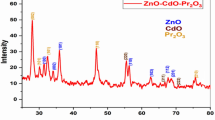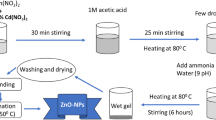Abstract
Photocatalytic processes are able to decompose dyes and toxic substances in the water environment. This fascinating topic can address many environmental concerns about polluted water. Zinc oxide is widely used as a photocatalyst in various nanocomposites. In this study, the formation of a nanostructure including cyclodextrin and ZnO has been investigated by density functional theory (DFT) in gas and aqueous phases at B3LYP and M06-2X functional levels. The calculated binding energies and natural bond orbital (NBO) analysis indicate the existence of strong chemical interactions of ZnO with the inside of the cyclodextrin (CD) cavity during CD-ZnO formation. In addition, the interaction of methylene blue (MB) and phenol red (PhR) dyes with CD-ZnO nanostructure has been investigated. The dyes’ adsorption energy values on the CD-ZnO ranged from − 243.4 to − 55.9 kJ. These energies and the density of states diagrams in their complexes confirm the strong interaction of MB and PhR with CD-ZnO. This strong interaction of dyes with nanostructure can support the mechanisms that lead to the photocatalytic degradation of dye molecules.





Similar content being viewed by others
Availability of data and materials
Derived data and the findings of this study are available from the corresponding author on request.
References
Hamdaoui O, Saoudi F, Chiha M, Naffrechoux E (2008) Sorption of malachite green by a novel sorbent, dead leaves of plane tree: Equilibrium and kinetic modeling. Chem Eng J 143:73–84
Pure Earth's Toxic Sites Identification Program, Switzerland (2016) World’s worst pollution problems. The new top six toxic threats: A priority list for remediation
Kant R (2012) Textile dyeing industry an environmental hazard. J Nat Sci 4(1):22–26
Kuppusamy S, Sethurajan M, Kadarkarai M, Aruliah R (2017) Biodecolourization of textile dyes by novel, indigenous Pseudomonas stutzeri MN1 and Acinetobacter baumannii MN3. J Environ Chem Eng 5:716–724
Baruah S, Dutta J (2009) Nanotechnology applications in population sensing and degradation in agriculture: a review. Envioron Chem Lett 7:161–204
Sugunan A, Dutta J (2008) Pollution treatment, remediation and sensing. Nanotechnology 3:125–143
Kumar SG, Devi LG (2011) Review on modified TiO2 photocatalysis under UV/visible light: selected results and related mechanisms on interfacial charge carrier transfer dynamics. J Phys Chem A 115:13211–13241
Linsebigler AL, Lu G, Yates JT Jr (1995) Photocatalysis on TiO2 surfaces: principles, mechanisms, and selected results. Chem Rev 95:735–758
Baruah S, Pal KS, Dutta J (2012) Nanostructured zinc oxide for water treatment. Nanoscience & Nanotechnology-Asia 2:90–102
Štengl V, Bakardjieva S, Murafa N (2009) Preparation and photocatalytic activity of rare earth doped TiO2 nanoparticles. Mater Chem Phys 114:217–226
Lin X, Rong F, Fu D, Yuan C (2012) Enhanced photocatalytic activity of fluorine doped TiO2 by loaded with Ag for degradation of organic pollutants. Powder Technol 219:173–178
Hayat K, Gondal MA, Khaled MM et al (2011) Nano ZnO synthesis by modified sol gel method and its application in heterogeneous photocatalytic removal of phenol from water. Appl Catal A Gen 393:122–129
Ullah R, Dutta J (2008) Photocatalytic degradation of organic dyes with manganese-doped ZnO nanoparticles. J Hazard Mater 156:194–200
Wu YL, Tok AIY, Boey FYC et al (2007) Surface modification of ZnO nanocrystals. Appl Surf Sci 253:5473–5479
Qamar M, Yamani ZH, Gondal MA, Alhooshani K (2011) Synthesis and comparative photocatalytic activity of Pt/WO3 and Au/WO3 nanocomposites under sunlight-type excitation. Solid State Sci 13:1748–1754
Qurashi A, Zhong Z, Alam MW (2010) Synthesis and photocatalytic properties of α-Fe2O3 nanoellipsoids. Solid State Sci 12:1516–1519
Malathy P, Vignesh K, Rajarajan M, Suganthi A (2014) Enhanced photocatalytic performance of transition metal doped Bi2O3 nanoparticles under visible light irradiation. Ceram Int 40:101–107
Zhang D, Zeng F (2010) Synthesis of an Ag–ZnO nanocomposite catalyst for visible light-assisted degradation of a textile dye in aqueous solution. Res Chem Intermed 36:1055–1063
Mishra YK, Adelung R, Röhl C et al (2011) Virostatic potential of micro–nano filopodia-like ZnO structures against herpes simplex virus-1. Antiviral Res 92:305–312
Janotti A, de Walle CG (2009) Fundamentals of zinc oxide as a semiconductor. Rep Prog Phys 72:126501
Mohan R, Krishnamoorthy K, Kim S-J (2012) Enhanced photocatalytic activity of Cu-doped ZnO nanorods. Solid State Commun 152:375–380
Divya NK, Pradyumnan PP (2016) Solid state synthesis of erbium doped ZnO with excellent photocatalytic activity and enhanced visible light emission. Mater Sci Semicond Process 41:428–435
Pathak TK, Swart HC, Kroon RE (2018) Structural and plasmonic properties of noble metal doped ZnO nanomaterials. Physica B Condens Matter 535:114–118
Liang Y, Guo N, Li L et al (2016) Facile synthesis of Ag/ZnO micro-flowers and their improved ultraviolet and visible light photocatalytic activity. New J Chem 40:1587–1594
Ahmad M, Yingying S, Nisar A et al (2011) Synthesis of hierarchical flower-like ZnO nanostructures and their functionalization by Au nanoparticles for improved photocatalytic and high performance Li-ion battery anodes. J Mater Chem 21:7723–7729
Olaru N, Calin G, Olaru L (2014) Zinc oxide nanocrystals grown on cellulose acetate butyrate nanofiber mats and their potential photocatalytic activity for dye degradation. Ind Eng Chem Res 53:17968–17975
Sivakumar K, Senthil Kumar V, Shim J-J, Haldorai Y (2014) Conducting copolymer/ZnO nanocomposite: synthesis, characterization, and its photocatalytic activity for the removal of pollutants. Synth React Inorg, Met-Org, Nano-Met Chem 44:1414–1420
Ghanem AF, Badawy AA, Mohram ME, Abdelrehim MH (2019) Enhancement the photocatalytic and biological activity of nano-sized ZnO using hyperbranched polyester. J Inorg Organomet Polym Mater 29:928–938
Di Mauro A, Cantarella M, Nicotra G et al (2017) Novel synthesis of ZnO/PMMA nanocomposites for photocatalytic applications. Sci Rep 7:40895
Jafari G, Raissi H, Saberinasab A, Pasban S (2023) Phosphatidylcholine in the tear film of the eye: enhanced topical delivery of fluorometholone to the eye. Inorg Chem Commun 150:110506
Yadav R, Chundawat TS, Rawat P et al (2021) Photocatalytic degradation of malachite green dye by ZnO and ZnO–β-cyclodextrin nanocomposite. Bull Mater Sci 44:1–8
Feng J, Miedaner A, Ahrenkiel P et al (2005) Self-assembly of photoactive TiO2- cyclodextrin wires. J Am Chem Soc 127:14968–14969
Zhou W, Pan K, Zhang L et al (2009) Solar-induced self-assembly of TiO 2–β-cyclodextrin–MWCNT composite wires. Phys Chem Chem Phys 11:1713–1718
Dimitrijevic NM, Rajh T, Saponjic ZV et al (2004) Light-induced charge separation and redox chemistry at the surface of TiO2/host- guest hybrid nanoparticles. J Phys Chem B 108:9105–9110
Rakshit S, Vasudevan S (2008) Resonance energy transfer from β-cyclodextrin-capped ZnO: MgO nanocrystals to included Nile Red guest molecules in aqueous media. ACS Nano 2:1473–1479
Tachikawa T, Tojo S, Fujitsuka M, Majima T (2006) One-electron oxidation pathways during β-cyclodextrin-modified TiO2 photocatalytic reactions. Chem Eur J 12:7585–7594
Choi H, Kang SO, Ko J et al (2009) An efficient dye-sensitized solar cell with an organic sensitizer encapsulated in a cyclodextrin cavity. Angew Chem 121:6052–6055
Chen L, Dionysiou DD, O’Shea K (2011) Complexation of microcystins and nodularin by cyclodextrins in aqueous solution, a potential removal strategy. Environ Sci Technol 45:2293–2300
Mennucci B (2012) Wiley Interdiscip Rev: Comput Mol Sci 2:10–1002
Frisch MJ, Trucks GW, Schlegel HB, Scuseria GE, Robb MA, Cheeseman JR, Scalmani G, Barone V, Mennucci B, Petersson GA et al (2009) 09 Revision D. 1, Gaussian. Inc, Wallingford CT 121:150–166
Chen M, Straatsma TP, Fang Z, Dixon DA (2016) Structural and electronic property study of (ZnO) n, n ≤ 168: Transition from zinc oxide molecular clusters to ultrasmall nanoparticles. J Phys Chem C 120:20400–20418
Calais J-L (1993) Density-functional theory of atoms and molecules. RG Parr and W. Yang, Oxford University Press, New York, Oxford, 1989. IX+ 333 pp. Price£ 45.00
Burke K (2012) Perspective on density functional theory. J Chem Phys 136:150901
Zhao Y, Truhlar DG (2008) The M06 suite of density functionals for main group thermochemistry, thermochemical kinetics, noncovalent interactions, excited states, and transition elements: two new functionals and systematic testing of four M06-class functionals and 12 other functionals. Theor Chem Acc 120:215–241
Miertuš S, Scrocco E, Tomasi J (1981) Electrostatic interaction of a solute with a continuum. A direct utilizaion of AB initio molecular potentials for the prevision of solvent effects. Chem Phys 55:117–129
Dennington R, Keith T, Millam J (2009) GaussView, Version 5.0. 8, R. KS: Dennington, Semichem Inc, Shawnee Mission
Boys SF, Bernardi F (1970) The calculation of small molecular interactions by the differences of separate total energies. Some procedures with reduced errors. Mol Phys 19:553–566
Glendening ED, Reed AE, Carpenter JE et al (1992) 3.1, Gaussian Inc. Pittsburgh PA
Lu T, Chen F (2012) Multiwfn: a multifunctional wavefunction analyzer. J Comput Chem 33:580–592
Shahab S, Yahyaei H, Sheikhi M et al (2021) Two new dichroic dyes: quantum chemical modeling, synthesis, optical properties and their application in polarizing films. J Mol Struct 1239:130353
Zaragoza I-P, Soriano-Agueda L-A, Hernández-Esparza R et al (2018) Analyzing ZnO clusters through the density-functional theory. J Mol Model 24:1–13
Saberinasab A, Raissi H, Hashemzadeh H (2020) Predicting the efficiency of polyethylene glycol-functionalised graphene in delivery of temozolomide anticancer drug and investigating the effect of pH on the drug release process: DFT and free energy calculations. Mol Simul 46:1474–1482
Saberinasab A, Raissi H, Hashemzadeh H (2019) Understanding the effect of vitamin B6 and PEG functionalization on improving the performance of carbon nanotubes in temozolomide anticancer drug transportation. J Phys D Appl Phys 52:395402
Yang Y-C, Huang W-Q, Xu L et al (2017) Hybrid TiO 2/graphene derivatives nanocomposites: is functionalized graphene better than pristine graphene for enhanced photocatalytic activity? Catal Sci Technol 7:1423–1432
Author information
Authors and Affiliations
Contributions
A. Gharebaghi wrote the main manuscript text; L. Hokmabadi performed the calculations; A. Heshmati Jannat Magham reviewed and edited the manuscript.
Corresponding author
Ethics declarations
Ethical approval
The order of the authors mentioned in this manuscript has been approved by the institution, and the intellectual property related to this work has been duly noted.
Competing interests
The authors declare no competing interests.
Additional information
Publisher's Note
Springer Nature remains neutral with regard to jurisdictional claims in published maps and institutional affiliations.
Rights and permissions
Springer Nature or its licensor (e.g. a society or other partner) holds exclusive rights to this article under a publishing agreement with the author(s) or other rightsholder(s); author self-archiving of the accepted manuscript version of this article is solely governed by the terms of such publishing agreement and applicable law.
About this article
Cite this article
Gharebaghi, A., Magham, A.H.J. & Hokmabadi, L. The methylene blue and phenol red photocatalytic degradation study by cyclodextrin-ZnO nanostructures. Struct Chem 35, 801–812 (2024). https://doi.org/10.1007/s11224-023-02230-z
Received:
Accepted:
Published:
Issue Date:
DOI: https://doi.org/10.1007/s11224-023-02230-z




